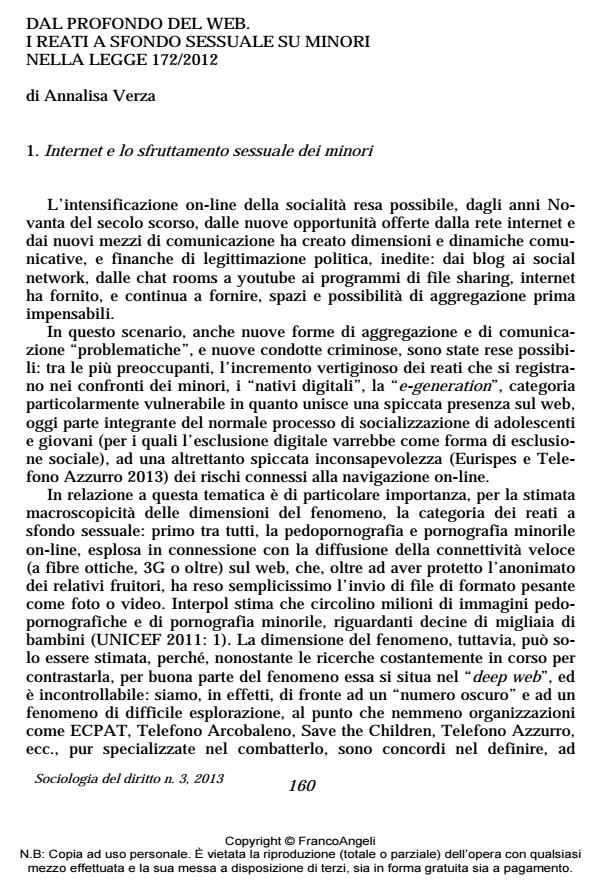From the depth of the web: paedophilia and paedo-pornography in Italian Law N° 172/2012
Journal title SOCIOLOGIA DEL DIRITTO
Author/s Annalisa Verza
Publishing Year 2014 Issue 2013/3 Language Italian
Pages 10 P. 160-169 File size 483 KB
DOI 10.3280/SD2013-003008
DOI is like a bar code for intellectual property: to have more infomation
click here
Below, you can see the article first page
If you want to buy this article in PDF format, you can do it, following the instructions to buy download credits

FrancoAngeli is member of Publishers International Linking Association, Inc (PILA), a not-for-profit association which run the CrossRef service enabling links to and from online scholarly content.
This article describes some of the most important innovations in the field of penal law, introduced by Italian Law N° 172/2012 which ratified the 2007 Lanzarote Convention on the Protection of Children against Sexual Exploitation and Sexual Abuse. Reflecting on its potential social impact, then author analyses it, from the introduction of the new crimes of incitement to commit acts of paedo-pornography and paedophilia (Art. 414.2) and of soliciting of minors (Art. 609.11), to amendments to the existing crimes of corruption of minors (Art. 609.5) and of juvenile pornography (Art. 600.3).
Keywords: Minors, Sexual abuse, Law 172/2012, Lanzarote Convention
- Adler, Amy, 2001. The Perverse Law of Child Pornography. The Columbia Law Review, 101: 209-73.
- De Bellis, Emilia e Piero Forno, 2011. Introduzione. In Nuove Prospettive nella tutela del minore. Il progetto C.U.R.E. e gli altri strumenti internazionali. Disponibile all’indirizzo: http://www.giustizia.it/resources/cms/documents/CURE.pdf
- Dimattia, Giuseppe, 2009. L’abuso sessuale e la tutela del bambino abusato. Minori Giustizia 3: 279-87, DOI: 10.3280/MG2009-003025
- EU Kids Online, 2011. Report, consultabile all’indirizzo http://www2.lse.ac.uk/media@lse/research/EUKidsOnline/EUKidsII%20%28200911%29/EUKidsOnlineIIReports/Final%20report.pdf
- Eurispes e Telefono Azzurro, 2013. Indagine conoscitiva sulla condizione dell’infanzia e dell’adolescenza in Italia.
- Ipsos e Save the Children, 2013. I ragazzi e il cyberbullismo. Disponibile all’indirizzo: http://www.fidae.it/AreaLibera/AreeTematiche/Condizione%20Giovanile/060213-stc-cyberbullismo-2013.pdf
- Livingstone, Sonia, 2010. Ragazzi online. Milano: Vita e pensiero.
- Meter Onlus, Osservatorio Mondiale contro la Pedofilia, 2013. Rapporto annuale 2012, disponibile all’indirizzo: http://www.associazionemeter.org/index.php?Itemid=150
- Resta, Eligio, 2009. Una storia della violenza. Minori Giustizia 3: 20-6, DOI: 10.3280/MG2009-003002
- Seto, Michael C., et al., 2006. Child Pornography Offenses Are a Valid Diagnostic Indicator of Pedophilia. In Journal of Abnormal Psychology, 115(3): 610–15, DOI: 10.1037/0021-843X.115.3.610
- Stella, Renato, 2012. Dark side: oscenità, sexting, pornografia e dintorni. In Minori Giustizia 4: 77-85, DOI: 10.3280/MG2012-004010
- Telefono Arcobaleno, 2011. Report Annuale: Contrasto della Pedofilia on-line – Anno 2011. Roma: Telefono Arcobaleno Onlus.
- UNICEF – Innocenti Research Centre, 2011. Child Safety Online. Global Challenges and Strategies. United Nations Children’s Fund.
- Verza, Annalisa, 2006. Il dominio pornografico. Napoli: Liguori.
- 2013. “Sexting” e pedopornografia: i paradossi. Ragion pratica 2: 569-592, DOI: 10.1415/7494
- L'infanzia violata. Devianza reticolare e digitalizzazione della pedopornografia Domenico Carzo, Antonia Cava, in SOCIOLOGIA DEL DIRITTO 3/2021 pp.116
DOI: 10.3280/SD2020-003006
Annalisa Verza, Dal profondo del web. Pedofilia e pedopornografia nella legge 172/2012 in "SOCIOLOGIA DEL DIRITTO " 3/2013, pp 160-169, DOI: 10.3280/SD2013-003008